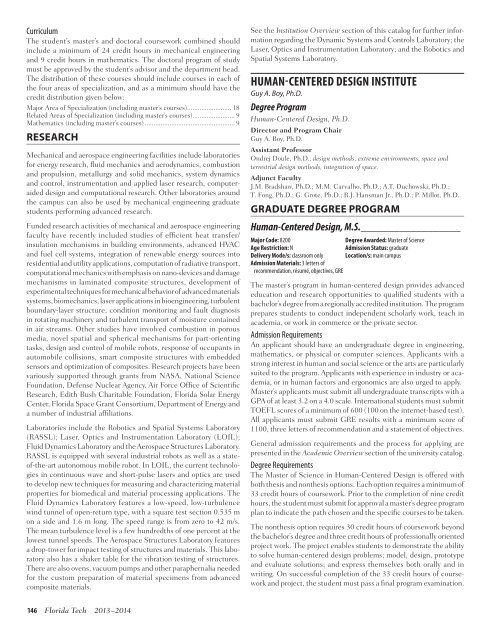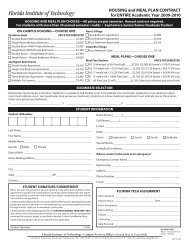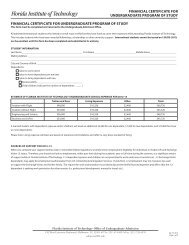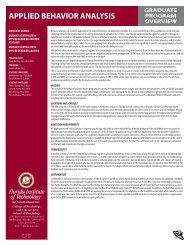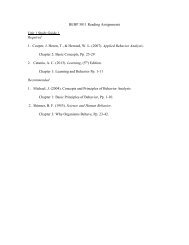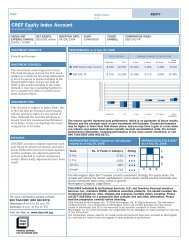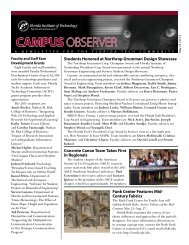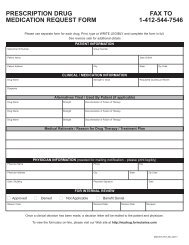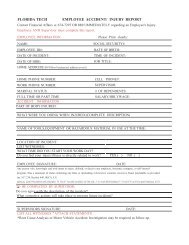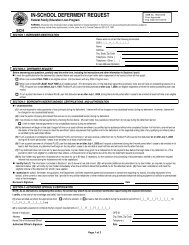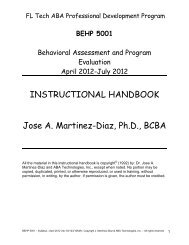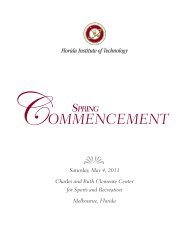2013–2014 UNIVERSITY CATALOG - Florida Institute of Technology
2013–2014 UNIVERSITY CATALOG - Florida Institute of Technology
2013–2014 UNIVERSITY CATALOG - Florida Institute of Technology
Create successful ePaper yourself
Turn your PDF publications into a flip-book with our unique Google optimized e-Paper software.
Curriculum<br />
The student’s master’s and doctoral coursework combined should<br />
include a minimum <strong>of</strong> 24 credit hours in mechanical engineering<br />
and 9 credit hours in mathematics. The doctoral program <strong>of</strong> study<br />
must be approved by the student’s advisor and the department head.<br />
The distribution <strong>of</strong> these courses should include courses in each <strong>of</strong><br />
the four areas <strong>of</strong> specialization, and as a minimum should have the<br />
credit distribution given below:<br />
Major Area <strong>of</strong> Specialization (including master’s courses) ......................... 18<br />
Related Areas <strong>of</strong> Specialization (including master’s courses)........................ 9<br />
Mathematics (including master’s courses) ................................................... 9<br />
RESEARCH<br />
Mechanical and aerospace engineering facilities include laboratories<br />
for energy research, fluid mechanics and aerodynamics, combustion<br />
and propulsion, metallurgy and solid mechanics, system dynamics<br />
and control, instrumentation and applied laser research, computeraided<br />
design and computational research. Other laboratories around<br />
the campus can also be used by mechanical engineering graduate<br />
students performing advanced research.<br />
Funded research activities <strong>of</strong> mechanical and aerospace engineering<br />
faculty have recently included studies <strong>of</strong> efficient heat transfer/<br />
insulation mechanisms in building environments, advanced HVAC<br />
and fuel cell systems, integration <strong>of</strong> renewable energy sources into<br />
residential and utility applications, computation <strong>of</strong> radiative transport,<br />
computational mechanics with emphasis on nano-devices and damage<br />
mechanisms in laminated composite structures, development <strong>of</strong><br />
experimental techniques for mechanical behavior <strong>of</strong> advanced materials<br />
systems, biomechanics, laser applications in bioengineering, turbulent<br />
boundary-layer structure, condition monitoring and fault diagnosis<br />
in rotating machinery and turbulent transport <strong>of</strong> moisture contained<br />
in air streams. Other studies have involved combustion in porous<br />
media, novel spatial and spherical mechanisms for part-orienting<br />
tasks, design and control <strong>of</strong> mobile robots, response <strong>of</strong> occupants in<br />
automobile collisions, smart composite structures with embedded<br />
sensors and optimization <strong>of</strong> composites. Research projects have been<br />
variously supported through grants from NASA, National Science<br />
Foundation, Defense Nuclear Agency, Air Force Office <strong>of</strong> Scientific<br />
Research, Edith Bush Charitable Foundation, <strong>Florida</strong> Solar Energy<br />
Center, <strong>Florida</strong> Space Grant Consortium, Department <strong>of</strong> Energy and<br />
a number <strong>of</strong> industrial affiliations.<br />
Laboratories include the Robotics and Spatial Systems Laboratory<br />
(RASSL); Laser, Optics and Instrumentation Laboratory (LOIL);<br />
Fluid Dynamics Laboratory and the Aerospace Structures Laboratory.<br />
RASSL is equipped with several industrial robots as well as a state<strong>of</strong>-the-art<br />
autonomous mobile robot. In LOIL, the current technologies<br />
in continuous wave and short-pulse lasers and optics are used<br />
to develop new techniques for measuring and characterizing material<br />
properties for biomedical and material processing applications. The<br />
Fluid Dynamics Laboratory features a low-speed, low-turbulence<br />
wind tunnel <strong>of</strong> open-return type, with a square test section 0.535 m<br />
on a side and 1.6 m long. The speed range is from zero to 42 m/s.<br />
The mean turbulence level is a few hundredths <strong>of</strong> one percent at the<br />
lowest tunnel speeds. The Aerospace Structures Laboratory features<br />
a drop-tower for impact testing <strong>of</strong> structures and materials. This laboratory<br />
also has a shaker table for the vibration testing <strong>of</strong> structures.<br />
There are also ovens, vacuum pumps and other paraphernalia needed<br />
for the custom preparation <strong>of</strong> material specimens from advanced<br />
composite materials.<br />
146 <strong>Florida</strong> Tech <strong>2013–2014</strong><br />
See the Institution Overview section <strong>of</strong> this catalog for further information<br />
regarding the Dynamic Systems and Controls Laboratory; the<br />
Laser, Optics and Instrumentation Laboratory; and the Robotics and<br />
Spatial Systems Laboratory.<br />
HUMAN-CENTERED DESIGN INSTITUTE<br />
Guy A. Boy, Ph.D.<br />
Degree Program<br />
Human-Centered Design, Ph.D.<br />
Director and Program Chair<br />
Guy A. Boy, Ph.D.<br />
Assistant Pr<strong>of</strong>essor<br />
Ondrej Doule, Ph.D., design methods, extreme environments, space and<br />
terrestrial design methods, integration <strong>of</strong> space.<br />
Adjunct Faculty<br />
J.M. Bradshaw, Ph.D.; M.M. Carvalho, Ph.D.; A.T. Duchowski, Ph.D.;<br />
T. Fong, Ph.D.; G. Grote, Ph.D.; R.J. Hansman Jr., Ph.D.; P. Millot, Ph.D.<br />
GRADUATE DEGREE PROGRAM<br />
Human-Centered Design, M.S. __________________<br />
Major Code: 8200 Degree Awarded: Master <strong>of</strong> Science<br />
Age Restriction: N Admission Status: graduate<br />
Delivery Mode/s: classroom only Location/s: main campus<br />
Admission Materials: 3 letters <strong>of</strong><br />
recommendation, résumé, objectives, GRE<br />
The master’s program in human-centered design provides advanced<br />
education and research opportunities to qualified students with a<br />
bachelor’s degree from a regionally accredited institution. The program<br />
prepares students to conduct independent scholarly work, teach in<br />
academia, or work in commerce or the private sector.<br />
Admission Requirements<br />
An applicant should have an undergraduate degree in engineering,<br />
mathematics, or physical or computer sciences. Applicants with a<br />
strong interest in human and social science or the arts are particularly<br />
suited to the program. Applicants with experience in industry or academia,<br />
or in human factors and ergonomics are also urged to apply.<br />
Master’s applicants must submit all undergraduate transcripts with a<br />
GPA <strong>of</strong> at least 3.2 on a 4.0 scale. International students must submit<br />
TOEFL scores <strong>of</strong> a minimum <strong>of</strong> 600 (100 on the internet-based test).<br />
All applicants must submit GRE results with a minimum score <strong>of</strong><br />
1100, three letters <strong>of</strong> recommendation and a statement <strong>of</strong> objectives.<br />
General admission requirements and the process for applying are<br />
presented in the Academic Overview section <strong>of</strong> the university catalog.<br />
Degree Requirements<br />
The Master <strong>of</strong> Science in Human-Centered Design is <strong>of</strong>fered with<br />
both thesis and nonthesis options. Each option requires a minimum <strong>of</strong><br />
33 credit hours <strong>of</strong> coursework. Prior to the completion <strong>of</strong> nine credit<br />
hours, the student must submit for approval a master’s degree program<br />
plan to indicate the path chosen and the specific courses to be taken.<br />
The nonthesis option requires 30 credit hours <strong>of</strong> coursework beyond<br />
the bachelor’s degree and three credit hours <strong>of</strong> pr<strong>of</strong>essionally oriented<br />
project work. The project enables students to demonstrate the ability<br />
to solve human-centered design problems; model, design, prototype<br />
and evaluate solutions; and express themselves both orally and in<br />
writing. On successful completion <strong>of</strong> the 33 credit hours <strong>of</strong> coursework<br />
and project, the student must pass a final program examination.


